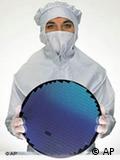Swiss researchers set new flexible solar cell efficiency record
Swiss laboratory Empa has taken a major step in the development of solar
power cells. Scientists have improved low-cost flexible cells to almost
match the efficiency rates of more expensive silicon or glass cells.
It's being billed as a small, but significant breakthrough in
harnessing renewable energy sources. On Thursday, Empa, the Swiss
Federal Laboratories for Materials Science and Technology, announced
that it had boosted the efficiency of flexible solar cells to a new
world record of 18.7 percent – a significant improvement over the
previous record of 17.6 percent (also set by Empa).
That might not sound like a huge improvement, but it potentially puts
flexible solar cells on a par with silicon or glass-based cells - which
are more efficient, but also heavier, bulkier and more expensive.
Efficiency is everything
Large flexible solar cells currently on the market have an efficiency
of only three or four percent, according to Ayodhya Tiwari, who led the
team at Empa's Laboratory for Thin Film and Photovoltaics. Silicon
solar panels, meanwhile, have an efficiency of 18 to 20 percent.
 Silicon requires purification before it can be used for solar panels Silicon requires purification before it can be used for solar panels
Flexible solar cells are made of a semi-conductor compound material
called copper indium gallium (di)selenide (known as CIGS for short),
which has a more complex cell structure than silicon.
Tiwari's team made the breakthrough by improving the structural
properties of the CIGS layer, which reduced recombination losses, and
using a polymer film rather than a metal foil as a carrier substrate for
the cells.
"In the field of solar energy, the bottom line is to have a low cost
of electricity that competes with conventional sources of power," Tiwari
told Deutsche Welle. "It's not yet there, but flexible solar cells have
the potential to give a lower cost – in manufacture, but also in
transportation and installation."
Friedrich Kessler, who leads a research team at the Center for Solar
Energy and Hydrogen Research Baden-Württemberg (ZSW), said Empa's
achievements were significant.
"I rate this very highly," he told Deutsche Welle. "It's a great
result that really gives me hope. I've made the measurements here, and I
can confirm these figures are real."
"I would say this group around Tiwari and Empa leads the field in the
area of plastic-based flexible solar cells," he added. "There's no-one
else in the world likely to take away their world record, which they've
held for years."
More complex, more flexible
The more conventional silicon solar cells have a high manufacturing
cost because they require special purification steps, while CIGS cells
can be mixed into an ink and printed onto a substrate material. This
makes CIGS cells thinner and more flexible.
CIGS cells have been known for over a decade, and were first
manufactured commercially in 2007, but up until now it has always been
accepted that, despite the cost advantages, silicon is more efficient.
But Tiwari says it's just a matter of catching up.
"Silicon technology is simply more mature than flexible solar cell
technology," he said. "But the significance of the new development is to
show that flexible solar cell technology can give you devices that are
as efficient as the ones you get with competing technologies."
 CIGS cells are lighter, so they have more uses CIGS cells are lighter, so they have more uses
Like potato chip packets
Another reason why flexible cells are easier to make than silicon
panels is because the technology can be adopted from other areas of
mass-manufacturing.
"Food packaging has been revolutionized by roll-to-roll
manufacturing," noted Tiwari. "Take a potato chips packet - if you peel
it off, it's nothing but plastic coated with a metal layer produced on a
roll-to-roll machine. That type of machine can be adapted to produce
flexible solar cells."
The key advantage of CIGS is not just the lower manufacturing costs, but also the lighter weight.
"It looks like a carpet. You can fold it, you can roll it," said
Tiwari. "And it has a few more applications - for instance if you want
to install on buildings that cannot support a heavy structure."
The perils of scaling up
The next challenge for Empa is to scale up their new CIGS cells to
manufacturing sizes without sacrificing too much efficiency. Generally,
the bigger the surface area of solar panels, the less efficient they
become.
Tiwari cannot yet say what efficiency levels they will achieve when
they scale up their new CIGS cells, but previous results suggest 16
percent efficiency is achievable. That would certainly give CIGS the
potential to compete with silicon solar panels.
"You have to make clear that these results have been achieved in a
laboratory, not in a production plant." warned Kessler. "They have to
show that this is possible in roll-to-roll production. But if they do
that, it is potentially technology that could be used both in energy
production and day-to-day application."
Author: Ben Knight
Editor: Cyrus Farivar
http://www.dw-world.de/dw/article/0,,15092972,00.html
|